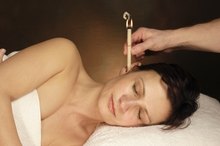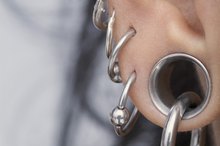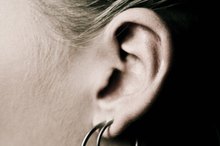How to Use Sleeper Earrings
Ear piercing is one of the earliest types of body modification. It was replaced by the popularity of clip-on earrings in the 1900s, but pierced ears came back in style in the 1950s. Many people pierced their own ears at home until jewelry stores and doctors began offering the service. Some people pierced their ears, removed the earrings for awhile and later found the holes closed. Repiercing can be painful, since the new hole usually goes through scar tissue, so it was easier to try to reopen the existing hole with a sleeper earring.
If you are experiencing serious medical symptoms, seek emergency treatment immediately.
Check your piercings to make sure the holes are fully healed. According to the Kid's Health website, ears take about four to six weeks to fully heal 2. During the healing time, keep the same earrings in your ears that the piercer used to pierce them.
How to Prevent Infection in Pierced Ears
Learn More
Select a size of sleeper earring. Sleeper earrings come in a variety of shapes and sizes, and were created to maintain the opening in the ear while providing comfort. The most popular are continuous hoops that lie flat against the ear while sleeping, and provide mobility to keep the piercing from growing around the earring.
Hold the ends of the earring between your thumb and first finger in each hand. Gently pull the two ends apart. On her website, Florida jeweler Maggie Imhof suggests twisting as you pull to remove the free end from the circular clasp without damaging the earring.
What to Do When an Ear Grows Over the Back of an Earring
Learn More
Press the free end of the sleeper earring through your pierced ear. Turn the earring so the clasp and the free end are below your earlobe. Use both hands to press the ends together so the free end catches in the circular clasp. Slide the earring around so the clasped section is hidden behind your earlobe.
Warnings
Don't use sleeper earrings until the holes are fully healed because the sleepers may cause the piercing to expand and potentially scar the ear.
Related Articles
References
- Maggie's Creations: Wear Earrings Again
- Kid's Health: Piercings
- National Environmental Health Association. Policy statement on ear piercing guns. 2018.
- Purim KS, Rosario BA, Rosario CS, Guimarães AT. Piercings in medical students and their effects on the skin. An Bras Dermatol. 2014;89(6):905-10. doi:10.1590/abd1806-4841.20142878
- Perry AW, Sosin M. Reconstruction of ear deformity from post-piercing perichondritis. Arch Plast Surg. 2014;41(5):609-12. doi:10.5999/aps.2014.41.5.609
- American Academy of Dermatology. What kids should know about getting piercing done safely.
- Goicochea E. Body piercing and health complications among college students in Puerto Rico. Walden UniversityWalden University ScholarWorks; 2017:20.
Writer Bio
Based in Dayton, Ohio, Sari Hardyal has been writing fitness, sports, entertainment and health-related articles for more than five years. Hardyal holds a Bachelor of Science in mass communication from Miami University and is pursuing her master's degree in occupational therapy and her doctorate in physical therapy. She is a certified personal trainer with the National Federation of Professional Trainers.









